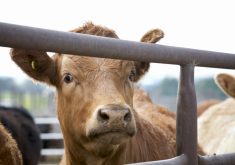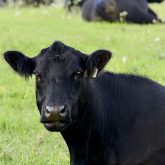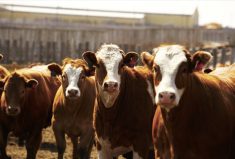If you’re a small meat processor, you can now manage your entire operation using your iPhone and a personal computer, thanks to an Alberta-created program called BioLinks.
“I wouldn’t want to run our business without BioLinks,” said Tim Hofer, manager of the Pine Haven Colony Meat shop.
The meat shop was a participant in the pilot project, and worked with Alberta Agriculture and Rural Development and a private software developer in the creation of the program. BioLinks uses a basic bar-code system to track every cut of meat from a carcass, which allows meat processors to simultaneously track sales and manage inventory while having full traceability.
Read Also

Farming Smarter receives financial boost from Alberta government for potato research
Farming Smarter near Lethbridge got a boost to its research equipment, thanks to the Alberta government’s increase in funding for research associations.
There are similar systems out there, but they are larger, more expensive, and more difficult to run, said Hofer.
“This program would meet the needs of small or large processors,” he said. “It’s not that large processors would run out of capacity. It’s more suited to small processors because it is affordable to them.”
- More from the Alberta Farmer Express: Verified Beef Production program gives producers an edge
The system costs about $1,500 to set up, and that’s key, said provincial business development specialist Vince McConnell.
“A lot of the systems that the big boys like Cargill have, they’re $250,000 systems,” he said.
“Now we’ve made a system that can perform as well as their systems, but a small-scale guy can use it and get some information back.”
BioLinks became commercially available earlier this year and is now being used by small processors in several provinces. The meat shop at Olds College, the Viking Hutterite Colony, and Spragg Meat Shops are some of the Alberta companies using BioLinks, which is being distributed by BIO, a company from Guelph.
The team at Pine Haven worked closely with McConnell and his Alberta Agriculture and Rural Development colleague Bert Dening and Drevertech, a programmer out of Camrose, to perfect the system. Government funds paid for years of program development.
To run the system, an iPhone is slipped into a sleeve called a “sled,” which contains a bar-code reader. It also connects the iPhone to a web-based database for managing inventory and sales (the phone uses Bluetooth technology to connect to a printer to print receipts).
“The fact that it is web based and can be shared with a computer is a very important feature,” said Hofer.
The technology allowed him to hire an assistant who can take phone orders, handle inquiries, and generate data about inventory all from her home.
The program has cut down on a lot of paper waste.
“We can fill orders online, fill orders with a scanner and email an invoice to the customer requesting payment,” said Hofer. “The customer will then give us a call and pay over the phone using a credit card.”
Processors using the system are finding unique ways to manage some of their data. For example, QR codes on packaging allow customers to trace information right back to an animal.
“A person who is eating that steak can actually take his iPhone, scan the package, and it brings him to the producer’s website,” said McConnell. “If he doesn’t like that meat, he can comment on it, and it automatically drops into the database, where the animal and production information is stored.”
Some processors are making marketing decisions based on the information they have gleaned from the system, said McConnell. VG Meats, a meat processor from Ontario, has been taking pictures of rib-eyes and tracking meat tenderness. The owner has created a price grid which reflects the true value of the cuts.
“He’s actually rewarding the producers who have true tender steaks and also, he’s doing a discount for the extra fat,” said McConnell. “We’re really getting some solid data on how the actual animals performed. And because we can collect the actual invoices from the sales of these animals, we get the true story. We get the true bottom line.”
The technology has been designed so it can one day be linked to the Beef InfoXchange System (BIXS).
Transitioning from manual data entry to a scanning technology does take some time, but is worth the effort, said McConnell.
“The data collected gives us some real good information for key production indicators on the farm for retail and for processing plants,” he said.
















